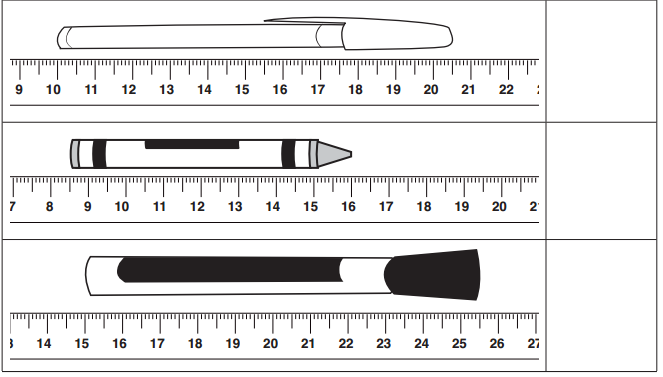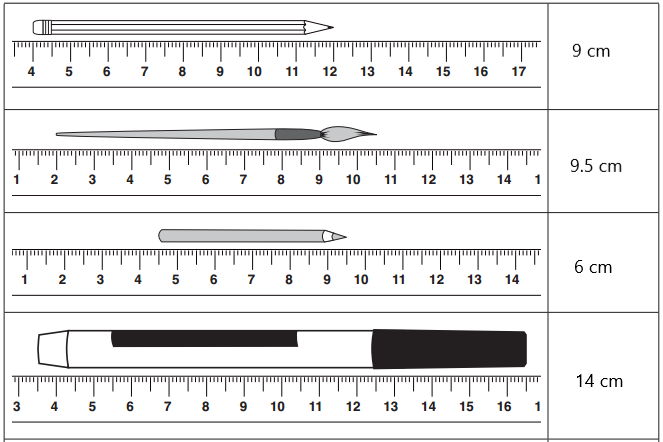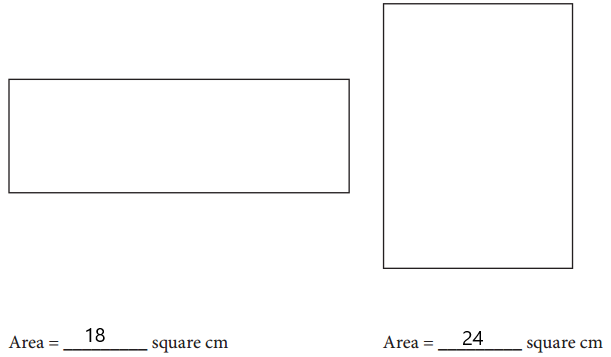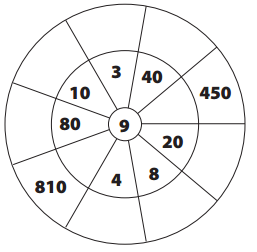Practicing the Bridges in Mathematics Grade 4 Student Book Answer Key Unit 1 Module 4 will help students analyze their level of preparation.
Bridges in Mathematics Grade 4 Student Book Answer Key Unit 1 Module 4
Bridges in Mathematics Grade 4 Student Book Unit 1 Module 4 Session 1 Answer Key
Linear Measurement
Label each measurement in centimeters.
The


Measure the length of the objects listed below. Label the units of measurement. Round your measurement to the nearest whole centimeter or use fractions.
Question 1.
Object to be Measured
Long side of this record sheet
Length in Centimeters
Answer:
10 cm.
Explanation:
The long side of this record sheet is 10 cm long.
Question 2.
Object to be Measured
Length of a new pencil
Length in Centimeters
Answer:
15 cm.
Explanation:
The length of a new pencil is 15 cm long.
Question 3.
Object to be Measured
Height of your desk
Length in Centimeters
Answer:
70 cm
Explanation:
The height of my desk is 70 cm.
Question 4.
Object to be Measured
Your cubit (length from elbow to tip of middle finger)
Length in Centimeters
Answer:
44 cm.
Explanation:
The length of your cubit in cm is 44 cm
Question 5.
CHALLENGE Measure and label the sides of both rectangles in centimeters. Then find the area of each in square centimeters.

Answer:

Explanation:
Given,
The length of the rectangle is 6
The width of the rectangle is 3 cm
The area of the rectangle is 6 × 3 = 18 square cm
Now let us find the area of the other rectangle
Length of the rectangle = 4 cm
The width of the rectangle is 6cm
Area = 4 × 6
= 24 square cm
Question 6.
Would you use centimeters or meters to measure the length of
a. your classroom? ________
Answer:
meters.
Explanation:
I would use meters to measure the length of your classroom.
b. your finger? ______
Answer:
centimeter.
Explanation:
I would use centimeters to measure the length of your finger.
c. a truck? ________
Answer:
Meters.
Explanation:
I would use meters to measure the length of a truck.
d. a newborn puppy? ________
Answer:
Meter.
Explanation:
I would use meters to measure the length of a truck.
Question 7.
If a desk was 4 times as long as the length of this page, how long would it be? Measure this record sheet in centimeters. Then write and solve an equation to show how long the desk would be.
Answer:
The desk is 16 cm long.
Given,
The desk is 4 times the length of the page
Length of the page = 2x
The desk will be = 8
The measurements are 2 and 8.
The equation is 2 × 8 = 16 cm long.
Question 8.
If the height of the door was 2 times the length of the desk in problem 7, how high would it be? Write and solve an equation to show how high the door would be.
Answer:
The area is 8 square cm
Explanation:
Let the length of the desk = 2 cm
The height of the door is 2 times the length of the desk
2 × 2 = 4 cm
The area would be 2 × 4 = 8 square cm.
Question 9.
A female grey whale is 2 times as long as a female killer whale. A female killer whale is 7 meters long. How long is a female grey whale in centimeters? Show your work.
A female grey whale is ____ centimeters long.
Answer:
14000 centimeters.
Explanation:
Given,
A female killer whale is 7 meters long.
A female grey whale is 2 times as long as a female killer whale
7 × 2 = 14 m
14 × 1000 = 14000 cm.
Measuring Materials
Question 1.
Fill in the multiple wheel.

Answer:

Explanation:
Let us solve the equations to fill in the multiple wheels.
Start solving from 3 × 9 = 27
9 × 40 = 360
450 ÷ 9 = 50
9 × 20 = 180
9 × 8 = 72
9 × 4 = 36
810 ÷ 9 = 90
720 ÷ 9 = 80
9 × 10 =90
Question 2.
Would you use centimeters or meters to measure the length of
a. your kitchen? __________
Answer:
meters.
Explanation:
The length of your kitchen is measured in meters.
b. your ear? ________
Answer:
centimeters.
Explanation:
The length of your ear is measured in centimeters.
c. a driveway? ______
Answer:
meters
Explanation:
The length of a driveway is measured in meters.
d. a goldfish? ______
Answer:
centimeters.
Explanation:
The length of a goldfish is measured in centimeters.
Question 3.
If a rug was 5 times as long as this record sheet, how long would it be? Measure the length of this record sheet in centimeters. Then write and solve an equation to show how long the rug would be in centimeters.
Answer:
140 cm.
Question 4.
Mr. Brown’s car is 4 meters long. The school bus is 3 times as long as Mr. Brown’s car. How many centimeters long is the school bus? Show your work.
The school bus is _____ centimeters long.
Answer:
1200 centimeters.
Bridges in Mathematics Grade 4 Student Book Unit 1 Module 4 Session 2 Answer Key
Weight & Mass Benchmarks
Complete this page after you’ve filled the 4 bags with beans to make benchmarks for 1 gram, 1 kilogram, 1 ounce, and 1 pound.
Question 1.
How many beans did it take to make 1 gram?
Answer:
1 bean.
Explanation:
It takes 1 bean to make 1 gram.
Question 2.
The prefix kilo means one thousand, so there are 1,000 grams in a kilogram. Write and solve a multiplication equation to show how many beans there are in your kilogram bag without counting them.
Answer:
1000 beans.
Explanation:
We know,
1 kg = 1000 grams
1 gram = 1 bean
then 1000 × 1 =1000 beans.
Question 3.
How many beans are there in the 1-ounce bag?
Answer:
4 beans in the 1-ounce bag.
Explanation:
There are 4 beans in the 1-ounce bag.
Question 4.
There are 16 ounces in a pound. Write and solve a multiplication equation to show how many beans there are in your pound bag without counting them.
Answer:
448 beans.
Explanation:
We know,
1 pound = 16 ounces
so
16 x 28 = 448
448 beans equal one pound
Question 5.
Which unit—the gram, kilogram, ounce, or pound—is the smallest?
Answer:
Ounces.
Explanation:
The unit ounce is the smallest one among the others.
Question 6.
Which unit—the gram, kilogram, ounce, or pound—is the largest?
Answer:
Kilogram.
Explanation:
The unit kilogram is the largest one.
Question 7.
About how many pounds do you think a kilogram weighs?
Answer:
2.20 pounds.
Explanation:
1 kilogram = 2.20 pounds.
Question 8.
Look around the classroom, and list 3 objects that have about the same weight or mass as each of the benchmark bags you made.

Answer:

Explanation:
We filled the table with the same weight or mass as each of the benchmark bags we made.
Weight & Mass Story Problems
For each problem, show your thinking with numbers, sketches, or words. Then write an equation that represents your work.
Question 1.
At the bakery down the street, you can get a small chocolate chip cookie that has a mass of 25 grams. You can get a giant chocolate chip cookie with a mass that is 5 times as much as a small chocolate chip cookie. What is the mass of the giant chocolate chip cookie?
![]()
Answer:
125 grams.
Explanation:

Question 2.
Ebony has a bag of grapes that weighs 8 ounces. Alex has 4 times as many bags of grapes, and each bag weighs 8 ounces. What is the weight of Alex’s bags of grapes in all?
![]()
Answer:
32 ounces or 2 pounds.
Explanation:

Question 3.
Sara was picking blueberries. She filled a 16-ounce container. Dan picked 3 times as many 16 ounce containers as Sara. How many ounces of blueberries did Dan pick?
![]()
Answer:
48 ounces or 3 pounds.
Explanation:

Bridges in Mathematics Grade 4 Student Book Unit 1 Module 4 Session 3 Answer Key
Comparing Quantities
For each problem, show your thinking with numbers, sketches, or words. Then write an equation that represents your work.
Question 1.
Millie and Sam are drinking water. Millie has 11 milliliters of water left in her water bottle. Sam has 4 times that much left in his water bottle. How many milliliters of water are left in Sam’s water bottle?
![]()
Answer:
44 ml
Explanation:

Question 2.
Miguel and Polly are drinking juice. Polly has 25 milliliters of juice left in her cup. Miguel has 4 times that much juice left in his cup. How many milliliters of juice does Miguel have left?
![]()
Answer:
100 ml
Explanation:

Question 3.
Hannah has an aquarium with 25 liters of water in it. How many milliliters of water are in the aquarium?
![]()
Answer:
25,000 ml
Explanation:

Question 4.
CHALLENGE Ruby scooped 25,000 milliliters of saltwater from her boat. How many liters of saltwater did she scoop?
![]()
Answer:
25 liters.
Explanation:
